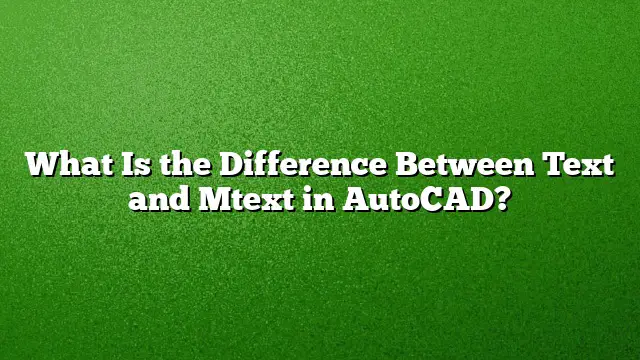Understanding Text and Mtext in AutoCAD
Defining Text and Mtext
Text in AutoCAD, often referred to as single-line text or Dtext, creates each line of text as an independent object. This method is suitable for brief annotations, allowing for straightforward labeling. Conversely, Mtext, or multiline text, supports complex formatting and is ideal for larger bodies of text, making it more versatile for detailed documentation.
Core Differences Between Text and Mtext
The primary distinction between text (Dtext) and Mtext lies in their structural composition:
- Object Composition: Text generates standalone lines, while Mtext forms a single entity capable of encompassing multiple lines.
- Formatting Capabilities: Mtext allows for a variety of font styles, sizes, and paragraph alignment within one text object. In contrast, Text is limited to a single style throughout.
When to Use Single Line Text
Single-line text is best utilized when a quick note or label is required. Each line exists independently, meaning adjustments to one will not affect others. This method is straightforward but lacks advanced formatting features.
- Creating Single Line Text:
- Access the Text command.
- Click to place your text and type the desired message.
- Press Enter to finalize and move to a new line if needed.
Utilizing Multiline Text
Mtext is necessary for more comprehensive documentation, enabling the inclusion of varying formatting elements like bullet points, numbered lists, and text wrapping.
- Creating Multiline Text:
- Select the Multiline Text tool from the Annotation panel.
- Define a bounding box for your text area.
- Input the text and utilize formatting options to customize appearance as needed.
Conversion Between Text and Mtext
AutoCAD provides functionality to switch between Text and Mtext formats, ensuring flexibility in your design workflow.
-
Converting Text to Mtext:
- Use the Express Tools command by selecting TXT2MTXT.
- Highlight the desired text objects and hit Enter.
- Review the MText Options dialog for additional settings if needed.
- Combining Single Line Text into Mtext:
- Navigate to the Express Tools and select Convert to Mtext.
- Choose all relevant single-line text items and press Enter to compile them into a multiline text entity.
Creating Text Styles
Setting appropriate text styles enhances readability and presentation within AutoCAD drawings.
-
For Text:
- Choose an existing style or create a new one by specifying parameters.
- For Mtext:
- Initiate the Mtext command and input text within the defined bounding box.
- After entering text, highlight segments for individual formatting alterations, if necessary.
Multiple Text Commands in AutoCAD
AutoCAD features two primary commands for text: Multiline text and Single line text. Each serves different purposes based on the complexity of the text required.
- Single-Line Text: Ideal for brief information and straightforward labeling.
- Multiline Text: Preferred when formatting, structure, and detailed presentation are paramount.
FAQs
1. Can I customize font styles in multiline text?
Yes, Mtext allows users to use various font styles within a single text object, enhancing visual distinction and readability.
2. What happens to Mtext if I explode it?
Exploding Mtext will break it down into individual text lines, converting the structured formatting into separate text objects, losing the advanced formatting.
3. Is it possible to modify existing text after it’s created?
Absolutely. Both Text and Mtext objects can be edited post-creation, allowing for adjustments to content and formatting as project requirements evolve.

